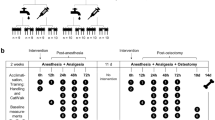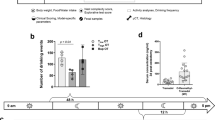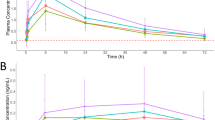Abstract
Buprenorphine is a long-acting opiate with a high therapeutic index. The authors review the pharmacology, toxicity, analgesic effects and delivery of buprenorphine for use in laboratory mice and rats. Buprenorphine-based analgesic therapy has a substantial record of safety, and there is growing evidence of its effectiveness for treating post-operative pain. Nonetheless, more research is needed to determine optimal delivery systems and analgesic regimens for pain therapy in laboratory animals.
This is a preview of subscription content, access via your institution
Access options
Subscribe to this journal
We are sorry, but there is no personal subscription option available for your country.
Buy this article
- Purchase on Springer Link
- Instant access to full article PDF
Prices may be subject to local taxes which are calculated during checkout
Similar content being viewed by others
References
Cowan, A., Lewis, J.W. & Macfarlane, I.R. Agonist and antagonist properties of buprenorphine, a new antinociceptive agent. Br. J. Pharmacol. 60, 537–545 (1977).
Cowan, A., Doxey, J.C. & Harry, E.J. The animal pharmacology of buprenorphine, an oripavine analgesic agent. Br. J. Pharmacol. 60, 547–54 (1977).
Orwin, J.M., Orwin, J. & Price, M. A double blind comparison of buprenorphine and morphine in conscious subjects following administration by the intramuscular route. Acta Anaesthesiol. Belg. 27, 171–181 (1976).
Campbell, N.D. & Lovell, A.M. The history of the development of buprenorphine as an addiction therapeutic. Ann. N Y Acad. Sci. 1248, 124–139 (2012).
Farris, H.E. Effects of indomethacin and buprenorphine analgesia on the postoperative recovery of mice. J. Am. Assoc. Lab. Anim. Sci. 47, 8 (2008).
Stokes, E.L., Flecknell, P.A. & Richardson, C.A. Reported analgesic and anaesthetic administration to rodents undergoing experimental surgical procedures. Lab. Anim. 43, 149–154 (2009).
Cowan, A. Buprenorphine: new pharmacological aspects. Int. J. Clin. Pract. Suppl. 113, 3–8 (2003).
Roughan, J.V. & Flecknell, P.A. Buprenorphine: a reappraisal of its antinociceptive effects and therapeutic use in alleviating post-operative pain in animals. Lab. Anim. 36, 322–343 (2002).
Gades, N.M., Danneman, P.J., Wixson, S.K. & Tolley, E.A. The magnitude and duration of the analgesic effect of morphine, butorphanol, and buprenorphine in rats and mice. Contemp. Top. Lab. Anim. Sci. 39, 8–13 (2000).
Karas, A. Postoperative analgesia in the laboratory mouse, Mus musculus. Lab. Anim. (NY) 31, 1–4 (2002).
Richardson, C.A. & Flecknell, P.A. Anesthesia and post-operative analgesia following experimental surgery in laboratory rodents: are we making progress? Altern. Lab. Anim. 33, 119–127 (2005).
Martin, W.R., Eades, C.G., Thompson, J.A., Huppler, R.E. & Gilbert, P.E. The effects of morphine- and nalorphine- like drugs in the nondependent and morphine-dependent chronic spinal dog. J. Pharmacol. Exp. Ther. 197, 517–532 (1976).
Virk, M.S., Arttamangkul, S., Birdsong, W.T. & Williams, J.T. Buprenorphine is a weak partial agonist that inhibits opioid receptor desensitization. J. Neurosci. 29, 7341–7348 (2009).
Tallarida, R.J., Cowan, A. & Raffa, R.B. On deriving the dose-effect relation of an unknown second component: an example using buprenorphine preclinical data. Drug Alcohol Depend. 109, 126–129 (2010).
Raffa, R.B. & Ding, Z. Examination of the preclinical antinociceptive efficacy of buprenorphine and its designation as full- or partial-agonist. Acute Pain 9, 145–152 (2007).
Yassen, A., Olofsen, E., Kan, J., Dahan, A. & Danhof, M. Pharmacokinetic-pharmacodynamic modeling of the effectiveness and safety of buprenorphine and fentanyl in rats. Pharm. Res. 25, 183–193 (2008).
Meyer, M.R. & Maurer, H.H. Absorption, distribution, metabolism and excretion pharmacogenomics of drugs of abuse. Pharmacogenomics 12, 215–233 (2011).
Gopal, S., Tzeng, T.B. & Cowan, A. Characterization of the pharmacokinetics of buprenorphine and norbuprenorphine in rats after intravenous bolus administration of buprenorphine. Eur. J. Pharm. Sci. 15, 287–293 (2002).
Pontani, R.B., Vadlamani, N.L. & Misra, A.L. Disposition in the rat of buprenorphine administered parenterally and as a subcutaneous implant. Xenobiotica 15, 287–297 (1985).
Yu, S. et al. Pharmacokinetics of buprenorphine after intravenous administration in the mouse. J. Am. Assoc. Lab. Anim. Sci. 45, 12–16 (2006).
Brown, S.M., Holtzman, M., Kim, T. & Kharasch, E.D. Buprenorphine metabolites, buprenorphine-3-glucuronide and norbuprenorphine-3-glucuronide, are biologically active. Anesthesiology 115, 1251–1260 (2011).
Heel, R.C., Brogden, R.N., Speight, T.M. & Avery, G.S. Buprenorphine: a review of its pharmacological properties and therapeutic efficacy. Drugs 17, 81–110 (1979).
Ponsoda, X. et al. The effects of buprenorphine on the metabolism of human hepatocytes. Toxicol. in Vitro. 5, 219–224 (1991).
Berson, A. et al. Mechanisms for experimental buprenorphine hepatotoxicity: major role of mitochondrial dysfunction versus metabolic activation. J. Hepatol. 34, 261–269 (2001).
Kugawa, F., Arae, K., Ueno, A. & Aoki, M. Buprenorphine hydrochloride induces apoptosis in NG108-15 nerve cells. Eur. J. Pharmacol. 347, 105–112 (1998).
Ferland, C., Veilleux-Lemieux, D. & Vachon, P. Effects of buprenorphine on intracerebral collagenase-induced hematoma in Sprague-Dawley rats. J. Am. Assoc. Lab. Anim. Sci. 46, 13–16 (2007).
Yulug, B., Cam, E., Yildiz, A. & Kilic, E. Buprenorphine does not aggravate ischemic neuronal injury in experimental focal cerebral ischemia. J. Neuropsychiatry Clin. Neurosci. 19, 331–334 (2007).
Kalliokoski, O. et al. The effect of voluntarily ingested buprenorphine on rats subjected to surgically induced global cerebral ischaemia. In Vivo 24, 641–646 (2010).
Nakamura, S., Kakinohana, M., Sugahara, K., Kinjo, S. & Miyata, Y. Intrathecal morphine, but not buprenorphine or pentazocine, can induce spastic paraparesis after a noninjurious interval of spinal cord ischemia in the rat. Anesth. Analg. 99, 1528–1531 (2004).
Wala, E.P. & Holtman, J.R. Jr. Buprenorphine-induced hyperalgesia in the rat. Eur. J. Pharmacol. 651, 89–95 (2011).
Malek, A. & Mattison, D.R. Drugs and medicines in pregnancy: the placental disposition of opioids. Curr. Pharm. Biotechnol. 12, 797–803 (2011).
Farid, W.O., Dunlop, S.A., Tait, R.J. & Hulse, G.K. The effects of maternally administered methadone, buprenorphine and naltrexone on offspring: review of human and animal data. Curr. Neuropharmacol. 6, 125–150 (2008).
Krueger, K.L. & Fujiwara, Y. The use of buprenorphine as an analgesic after rodent embryo transfer. Lab Anim. (NY) 37, 87–90 (2008).
Goulding, D.R. et al. The effects of perioperative analgesia on litter size in Crl:CD1(ICR) mice undergoing embryo transfer. J. Am. Assoc. Lab. Anim. Sci. 49, 423–426 (2010).
Hutchings, D.E., Zmitrovich, A.C., Hamowy, A.S. & Liu, P.Y. Prenatal administration of buprenorphine using the osmotic minipump: a preliminary study of maternal and offspring toxicity and growth in the rat. Neurotoxicol. Teratol. 17, 419–423 (1995).
Robinson, S.E. & Wallace, M.J. Effect of perinatal buprenorphine exposure on development in the rat. J. Pharmacol. Exp. Ther. 298, 797–804 (2001).
Robinson, S.E. Effects of perinatal buprenorphine and methadone exposures on striatal cholinergic ontogeny. Neurotoxicol. Teratol. 24, 137–142 (2002).
Chiang, Y.C., Hung, T.W., Lee, C.W., Yan, J.Y. & Ho, I.K. Enhancement of tolerance development to morphine in rats prenatally exposed to morphine, methadone, and buprenorphine. J. Biomed. Sci. 17, 46 (2010).
Banerjee, D. & Sarkar, N.K. Haematological changes in buprenorphine-treated mice. Folia Biol. (Krakow) 45, 157–162 (1997).
Volker, D., Bate, M., Gentle, R. & Garg, M. Oral buprenorphine is anti-inflammatory and modulates the pathogenesis of streptococcal cell wall polymer-induced arthritis in the Lew/SSN rat. Lab. Anim. 34, 423–429 (2000).
Hall, T.J., Jagher, B., Schaeublin, M. & Wiesenberg, I. The analgesic drug buprenorphine inhibits osteoclastic bone resorption in vitro, but is proinflammatory in rat adjuvant arthritis. Inflamm. Res. 45, 299–302 (1996).
Van Loveren, H., Gianotten, N., Hendriksen, C.F., Schuurman, H.J. & Van der Laan, J.W. Assessment of immunotoxicity of buprenorphine. Lab. Anim. 28, 355–363 (1994).
Hugunin, K.M., Fry, C., Shuster, K. & Nemzek, J.A. Effects of tramadol and buprenorphine on select immunologic factors in a cecal ligation and puncture model. Shock 34, 250–260 (2010).
Martucci, C., Panerai, A.E. & Sacerdote, P. Chronic fentanyl or buprenorphine infusion in the mouse: similar analgesic profile but different effects on immune responses. Pain 110, 385–392 (2004).
Swenson, J., Olgun, S., Radjavi, A., Kaur, T. & Reilly, C.M. Clinical efficacy of buprenorphine to minimize distress in MRL/lpr mice. Eur. J. Pharmacol. 567, 67–76 (2007).
Lindsay, D.S. et al. Buprenorphine does not affect acute murine toxoplasmosis and is recommended as an analgesic in Toxoplasma gondii studies in mice. J. Parasitol. 91, 1488–1490 (2005).
D'Elia, M., Patenaude, J., Hamelin, C., Garrel, D.R. & Bernier, J. No detrimental effect from chronic exposure to buprenorphine on corticosteroid-binding globulin and corticosensitive immune parameters. Clin. Immunol. 109, 179–187 (2003).
Hanson, C.E., Ruble, G.R., Essiet, I. & Hartman, A.B. Effects of buprenorphine on immunogenicity and protective efficacy in the guinea pig keratoconjunctivitis model (Sereny test). Comp. Med. 51, 224–229 (2001).
Gueye, P.N. et al. Lack of effect of single high doses of buprenorphine on arterial blood gases in the rat. Toxicol. Sci. 62, 148–154 (2001).
Chevillard, L., Mégarbane, B., Risède, P. & Baud, F.J. Characteristics and comparative severity of respiratory response to toxic doses of fentanyl, methadone, morphine, and buprenorphine in rats. Toxicol. Lett. 191, 327–340 (2009).
Dahan, A. et al. Comparison of the respiratory effects of intravenous buprenorphine and fentanyl in humans and rats. Br. J. Anaesth. 94, 825–834 (2005).
Ohtani, M., Kotaki, H., Nishitateno, K., Sawada, Y. & Iga, T. Kinetics of respiratory depression in rats induced by buprenorphine and its metabolite, norbuprenorphine. J. Pharmacol. Exp. Ther. 281, 428–433 (1997).
Yassen, A., Olofsen, E., Kan, J., Dahan, A. & Danhof, M. Animal-to-human extrapolation of the pharmacokinetics and pharmacodynamic properties of buprenorphine. Clin. Pharmacokinet. 46, 433–447 (2007).
Adamson, T.W. et al. Assessment of carprofen and buprenorphine on recovery of mice after surgical removal of the mammary fat pad. J. Am. Assoc. Lab. Anim. Sci. 49, 610–616 (2010).
Watson, P.J., McQuay, H.J., Bullingham, R.E., Allen, M.C. & Moore, R.A. Single-dose comparison of buprenorphine 0.3 and 0.6 mg i.v. given after operation: clinical effects and plasma concentration. Br. J. Anaesth. 54, 37–43 (1982).
Chawarski, M.C., Schottenfeld, R.S., O'Connor, P.G. & Pakes, J. Plasma concentrations of buprenorphine 24 to 72 hours after dosing. Drug Alcohol Depend. 55, 157–163 (1999).
Yassen, A., Olofsen, E., Dahan, A. & Danhof, M. Pharmacokinetic-Pharmacodynamic modeling of the antinociceptive effect of buprenorphine and fentanyl in rats: Role of receptor equilibration kinetics. J. Pharmacol. Exp. Ther. 313, 1136–1149 (2005).
Liu, K.S. et al. Novel depots of buprenorphine have a long-acting effect for the management of physical dependence to morphine. J. Pharm. Pharmacol. 58, 337–344 (2006).
Christoph, T. et al. Broad analgesic profile of buprenorphine in rodent models of acute and chronic pain. Eur. J. Pharmacol. 507, 87–98 (2005).
Canta, A. et al. Continuous buprenorphine delivery effect in streptozotocine-induced painful diabetic neuropathy in rats. J. Pain 10, 961–968 (2009).
Tubbs, J.T. et al. Effects of buprenorphine, meloxicam, and flunixin meglumine as postoperative analgesia in mice. J. Am. Assoc. Lab. Anim. Sci. 50, 185–191 (2011).
Jablonski, P., Howden, B.O. & Baxter, K. Influence of buprenorphine analgesia on post-operative recovery in two strains of rats. Lab. Anim. 35, 213–222 (2001).
Bourque, S.L., Adams, M.A., Nakatsu, K. & Winterborn, A. Comparison of buprenorphine and meloxicam for postsurgical analgesia in rats: effects on body weight, locomotor activity, and hemodynamic parameters. J. Am. Assoc. Lab. Anim. Sci. 49, 617–622 (2010).
Brennan, M.P., Sinusas, A.J., Horvath, T.L., Collins, J.G. & Harding, M.J. Correlation between body weight changes and postoperative pain in rats treated with meloxicam or buprenorphine. Lab Anim. (NY) 38, 87–93 (2009).
Gillingham, M.B., Clarke, M.D., Dahly, E.M., Krugner-Higby, L.A. & Ney, D.M. A comparison of two opioid analgesics for relief of visceral pain induced by intestinal resection in rats. Contemp. Top. Lab. Anim. Sci. 40, 21–26 (2001).
Matsumiya, L.C. et al. Using the Mouse Grimace Scale to reevaluate the efficacy of postoperative analgesia in laboratory mice. J. Am. Assoc. Lab. Anim. Sci. 51, 42–49 (2012).
McKeon, G.P. et al. Analgesic effects of tramadol, tramadol-gabapentin, and buprenorphine in an incisional model of pain in rats (Rattus norvegicus). J. Am. Assoc. Lab. Anim. Sci. 50, 192–197 (2011).
Chappell, M.G., Koeller, C.A. & Hall, S.I. Differences in postsurgical recovery of CF1 mice after intraperitoneal implantation of radiotelemetry devices through a midline or flank surgical approach. J. Am. Assoc. Lab. Anim. Sci. 50, 227–237 (2011).
Karas, A.Z. Barriers to assessment and treatment of pain in laboratory animals. Lab. Anim. (NY) 35, 38–45 (2006).
Cooper, D.M., Hoffman, W., Wheat, N. & Lee, H.Y. Duration of effects on clinical parameters and referred hyperalgesia in rats after abdominal surgery and multiple doses of analgesia. Comp. Med. 55, 344–353 (2005).
Stewart, L.S. & Martin, W.J. Influence of postoperative analgesics on the development of neuropathic pain in rats. Comp. Med. 53, 29–36 (2003).
Biaha, M.D. & Leon, L.R. Effects of indomethacin and buprenorphine analgesia on the postoperative recovery of mice. J. Am. Assoc. Lab. Anim. Sci. 47, 8–19 (2008).
Bomzon, A. Are repeated doses of buprenorphine detrimental to postoperative recovery after laparotomy in rats? Comp. Med. 56, 114–118 (2006).
Guarnieri, M., Carson, B.S., Khan, A., Penno, M. & Jallo, G.I. Flexible versus rigid catheters for chronic administration of exogenous agents into central nervous system tissues. J. Neurosci. Methods 144, 147–152 (2005).
Curtin, L.I. et al. Evaluation of buprenorphine in a post-operative pain model in rats. Comp. Med. 59, 60–71 (2009).
Jessen, L., Christensen, S. & Bjerrum, O.J. The antinociceptive efficacy of buprenorphine administered through the drinking water of rats. Lab. Anim. 41, 185–96 (2007).
Leach, M.C., Forrester, A.R. & Flecknell, P.A. Influence of preferred foodstuffs on the antinociceptive effects of orally administered buprenorphine in laboratory rats. Lab. Anim. 44, 54–58 (2010).
van Loo, P.L. et al. Analgesics in mice used in cancer research: reduction of discomfort? Lab. Anim. 31, 318–325 (1997).
Kalliokoski, O., Jacobsen, K.R., Hau, J. & Abelson, K.S. Serum concentrations of buprenorphine after oral and parenteral administration in male mice. Vet. J. 187, 251–254 (2011).
Goldkuhl, R., Jacobsen, K.R., Kalliokoski, O., Hau, J. & Abelson, K.S. Plasma concentrations of corticosterone and buprenorphine in rats subjected to jugular vein catheterization. Lab. Anim. 44, 337–343 (2010).
Park, I. et al. Buprederm, a new transdermal delivery system of buprenorphine: pharmacokinetic, efficacy and skin irritancy studies. Pharm. Res. 25, 1052–1062 (2008).
Yun, M.H., Jeong, S.W., Pai, C.M. & Kim, S.O. Pharmacokinetic-pharmacodynamic modeling of the analgesic effect of Buprederm in mice. Health 2, 824–831 (2010).
Pontani, R.B. & Misra, A.L. A long-acting buprenorphine delivery system. Pharmacol. Biochem. Behav. 18, 471–474 (1983).
Forbes, N. et al. Morbidity and mortality rates associated with serial bleeding from the superficial temporal vein in mice. Lab Anim. (NY) 39, 236–240 (2010).
Foley, P.L., Liang, H. & Crichlow, A.R. Evaluation of a sustained-release formulation of buprenorphine for analgesia in rats. J. Am. Assoc. Lab. Anim. Sci. 50, 198–204 (2011).
Hayes, K.E., Raucci, J.A. Jr., Gades, N.M. & Toth, L.A. An evaluation of analgesic regimens for abdominal surgery in mice. Contemp. Top. Lab. Anim. Sci. 39, 18–23 (2000).
Author information
Authors and Affiliations
Corresponding author
Ethics declarations
Competing interests
The authors declare competing financial interests. Funding to support this work was obtained from the biotechnology and economic development programs of Maryland Technology Development Corporation (TEDCO) and Maryland Industrial Partnerships (MIPS) and from Bamvet Laboratories, Inc. P.Z. is a paid consultant for Bamvet and is supported by a Johns Hopkins Medical Research Fellowship. M.G. holds a significant financial interest in Bamvet.
Rights and permissions
About this article
Cite this article
Guarnieri, M., Brayton, C., DeTolla, L. et al. Safety and efficacy of buprenorphine for analgesia in laboratory mice and rats. Lab Anim 41, 337–343 (2012). https://doi.org/10.1038/laban.152
Received:
Accepted:
Published:
Issue Date:
DOI: https://doi.org/10.1038/laban.152
This article is cited by
-
Reproducible strategy for excisional skin-wound-healing studies in mice
Nature Protocols (2024)
-
A buprenorphine depot formulation provides effective sustained post-surgical analgesia for 72 h in mouse femoral fracture models
Scientific Reports (2023)
-
Anesthesia and analgesia for common research models of adult mice
Laboratory Animal Research (2022)
-
A new S. suis serotype 3 infection model in pigs: lack of effect of buprenorphine treatment to reduce distress
BMC Veterinary Research (2022)
-
Buprenorphine alters microglia and astrocytes acutely following diffuse traumatic brain injury
Scientific Reports (2021)



